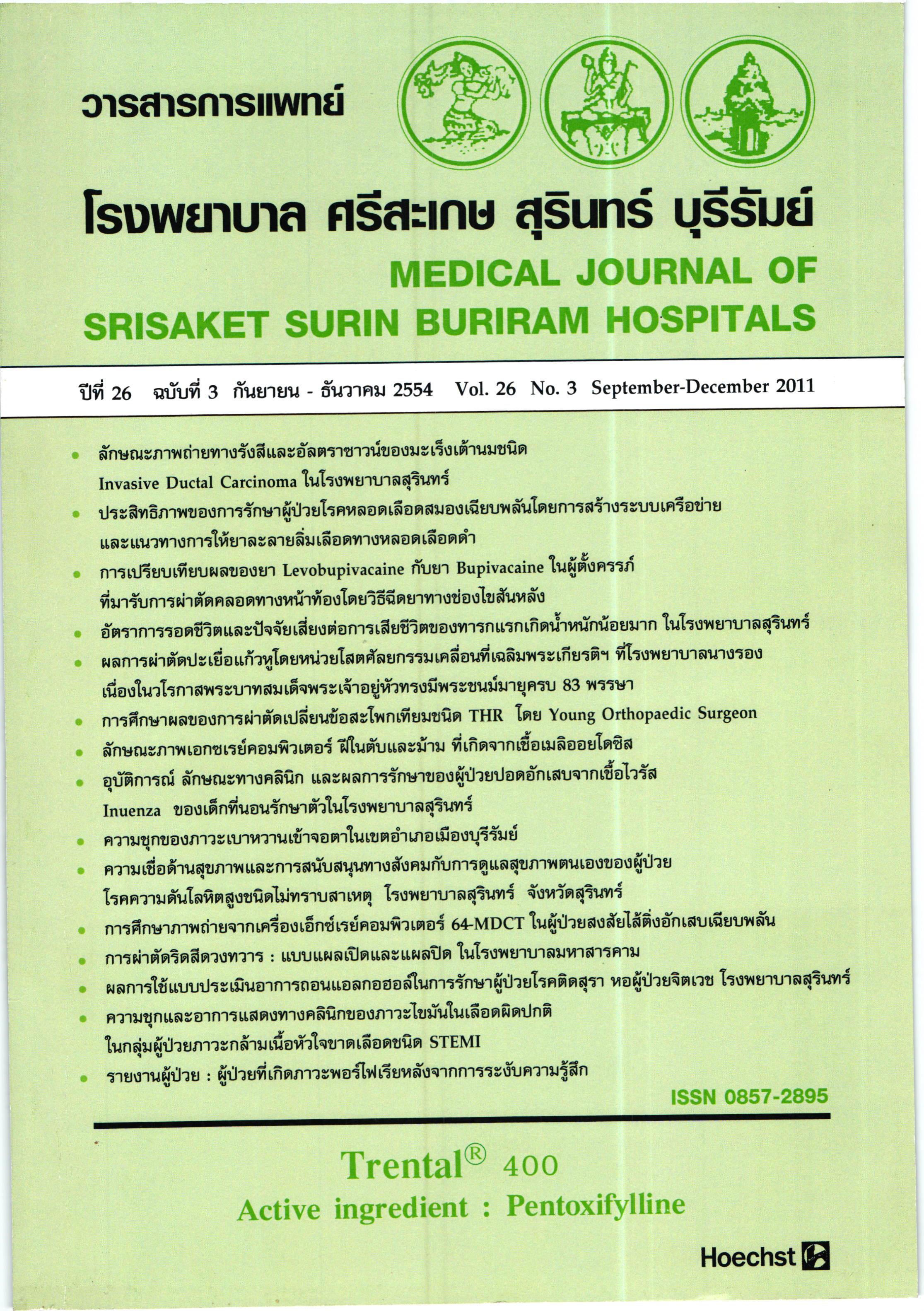การเปรียบเทียบผลของยา Levobupivacaine กับยา Bupivacaine ในผู้ตั้งครรภ์ ที่มารับการผ่าตัดคลอดทางหน้าท้องโดยวิธีฉีดยาทางช่องไขสันหลัง
Main Article Content
บทคัดย่อ
บทนำ: วิธีการระงับความรู้สึกที่นิยมสำหรับการผ่าตัดคลอดทางหน้าท้องคือการฉีดยาชาเฉพาะที่ เนื่องจากทำได้ง่าย มีความปลอดภัยสูง ในปัจจุบันมีการปรับปรุงยาชาสำหรับบริหารเข้าช่องไขสันหลังให้เลือกใช้มากขึ้น เช่นยา levobupivacaine ซึ่งมีโครงสร้างยาคล้ายคลึงกับ bupivacaine สามารถระงับปวดได้ดีและไม่พบผลข้างเคียงที่เป็นอันตรายรุนแรง
วัตถุประสงค์การวิจัย: เพื่อศึกษาผลของยาเชิงคลินิกและเปรียบเทียบการระงับปวดของยาในกลุ่มทดลอง คือ levobupivacaine ผสม morphine กับยาในกลุ่มควบคุม คือ bupivacaine ผสม morphine ทางช่องไขสันหลังในสตรีตั้งครรภ์ที่มารับการผ่าตัดคลอดทางหน้าท้อง
รูปแบบการวิจัย: เป็นการศึกษาแบบกึ่งทดลอง (Prospective, randomized controlled study)
วิธีการศึกษา: ศึกษาในสตรีตั้งครรภ์ที่มารับการผ่าตัดคลอดทางหน้าท้องแบบไม่เร่งด่วน ในโรงพยาบาล สุรินทร์โดยศึกษา ระหว่างวันที่ 1 พฤษภาคม ถึง 31 กรกฎาคม 2554 จำนวนทั้งสิ้น 72 ราย วิเคราะห์ข้อมูลโดยใช้สถิติวิเคราะห์ Nonparametric Mann Whitney U test, Chi square tests, Independent t-test ค่า p value <0.05 จึงจะถือว่ามีนัยสำคัญทางสถิติ
ผลการศึกษา: ผลการศึกษาพบว่า ยาในกลุ่มทดลองมีประสิทธิภาพในการระงับปวดสำหรับการผ่าตัดคลอดได้ดีใกล้เคียงกับยาในกลุ่มควบคุม โดยพบภาวะแทรกซ้อนภาวะความดันโลหิตต่ำ เพียง 30.6% ในขณะที่ผู้ตั้งครรภ์สามารถขยับขาได้เร็วกว่าโดยพบว่าเวลาที่ผู้ตั้งครรภ์ สามารถยกขาได้เต็มที่เร็วกว่าอย่างมีนัยสำคัญทางสถิติคือ 221 นาที (117-325) ขณะที่กลุ่ม ควบคุมทำได้เมื่อเวลาผ่านไป 246 นาที (183-307) ซึ่งส่งผลให้ในช่วงหลังผ่าตัดผู้ตั้งครรภ์ รู้สึกสุขสบายกว่าอย่างมีนัยสำคัญทางสถิติ ส่วนความพึงพอใจในผลระงับปวดช่วงระหว่าง และหลังผ่าตัดพบว่าไม่มีความแตกต่างกันทางสถิติ แต่มีรายงานอาการคันช่วง 24 ชั่วโมง หลังผ่าตัดถึงร้อยละ 80 ซึ่งมากกว่ากลุ่มทดลองที่มีรายงานร้อยละ 52.8 อย่างมีนัยสำคัญทางสถิติ
สรุป: Levobupivacaine ผสม morphine สามารถให้ผลระงับปวดได้ดีเพียงพอสำหรับการผ่าตัดคลอด โดยผู้ตั้งครรภ์มีความดันโลหิตคงที่ สามารถขยับข้อเท้า และยกขาได้เร็ว แม้ว่า จะมีรายงานอาการคันเป็นภาวะแทรกซ้อนหลังผ่าตัดมากกว่าอย่างมีนัยสำคัญทางสถิติ แต่ส่วนใหญ่เป็นระดับอาการเล็กน้อย ไม่รุนแรงและไม่ได้ขอยาใดๆ
Article Details
เอกสารอ้างอิง
277-84.
2. Chestnut HD. Anesthesia and Maternal Mortality. Anesthesiology 1997; 86:2: 273-6.
3. Hodgson CA, Wauchob TD. A comparison of spinal and general anaesthesia for elective caesarean section: effect on neonatal condition at birth. International Journal of Obstetric Anesthesia 1994; 3:1:25-30.
4. Hawkins JL, Chang J, Callaghan W, Gibbs CP, Palmer SK. Anesthesia-Related Maternal Mortality in the United States, 1991-1996. An Update. Anesthesiology 2002;96: A1046
5. Urmey WF. Regional Anesthesia Topic of the Week: Obstetric Anesthesia, [online], 2009 [Cited 2011; Nov 28] ; Available from :URL:https://www.nysora.com
6. Dahl JB, Jeppesen IS, Jorgensen H, Wetterslev J, Moiniche S. Intraoperative and Postoperative Analgesic Efficacy and Adverse Effects of Intrathecal Opioids in Patients Undergoing Cesarean Section with Spinal Anesthesia . A Qualitative and Quantitative Systematic Review of Randomized Controlled Trials. Anesthesiology 1999; 91:1919-27
7. Gehling M, Tryba M. Risks and side- effects of intrathecal morphine combined with spinal anaesthesia: a meta-analysis. Anaesthesia. 2009 Jun;64(6):643-51
8. P. Kirdemir, S. Ozmen, T. Tuncer Peker, D. Karaaslan. Comparison of intrathecal levobupivacaine and levobupivacaine morphine for caesarean delivery 378 (randomized study). Turkiye Ktinikleri J Gynecol Obst 2009;19(1):7-11
9. Brian Gennery, Laurence E. Mather, and Gary Strichartz. Levobupivacaine: New Predinical and Clinical Data. Seminars in Anesthesia, Perioperative Medicine and Pain 2000 June; 19(2): 132-148
10. Andrea Casati, Marta Putzu. Bupiva-caine, levobupivacaine and ropivacaine: Are they clinically different? Clinical anaesthesiology 2005; 19(2): 247-268
11. Michela Camorcia, Giorgio Capogna, Cristiana Berritta, and Malachy o. Columb. The relative potencies for motor block after intrathecal Ropivacaine, Levobupivacaine and Bupi vacaine. Anesthesia and analgesia 2007 Apr;104(4):904(7)
12. Bartz, Albert E. Basic Statistical Concept. New Jersey : Prentice-Hall, Inc., 1999.
17. Loether, Herman J. and Mctavish, Donald G. Descriptive and inferential Statistics : An Introduction. USA : Allyn and Bacon, 1993
13. P. Gautier, M. De Kock, L. Huberty, T. Demir, M. Izydorczic and B. Vanderick. Comparison of the effects of intrathecal ropivacaine, levobupivacaine, and bupivacaine for Caesarean section. BJA 2003; 91(5):684-689
14. R. Parpaglioni, M. G. Frigo, A. Lemma, M. Sebastiani, G. Barbati and D. Celleno. Minimum local anaesthetic dose (MLAD) of intrathecal levobupivacaine and
ropivacaine for Caesarean section. Anaesthesia 2006; 61:110-115
15. Bremerich DH, Kuschel S, Fetsch N, Zwissler B, Byhahn C, Meininger D. Levobupivacaine for parturients undergoing elective caesarean delivery. A dose-finding investigation. Anaesthesist 2007 Aug;56(8):772-9
16. Dorothee H. Bremericha, Nathalie Fetschb, Bernhard C. Zwisslerb, Dirk Meiningerb, Wiebke Gogartenc and Christian Byhahnb. Comparison of intrathecal bupivacaine and levobupivacaine combined with opioid for cesarean section. Curr Med Res opin. 2007 Dec; 23(12): 3047-54
17. Joy L Steadman, Meraj N Siddiqui. Does Intrathecal Morphine Sulfate for Postoperative Cesarean Section Pain Management Cause More Side Effects Than Epidural Morphine Sulphate? Anesthesiology Abstracts of Scientific Papers Annual Meeting 2002; 90: A 1045
18. M. Swart, J. Sewell, D. Thomas. Intrathecal morphine for Caesarean section: an assessment of pain relief, satisfaction and side-effects. Anaesthesia 1997;52(4); 373-377
19. Mark A. Chaney. Review Article; Side effects of intrathecal and epidural opioids. Can J Anesth;42(10):891-903


